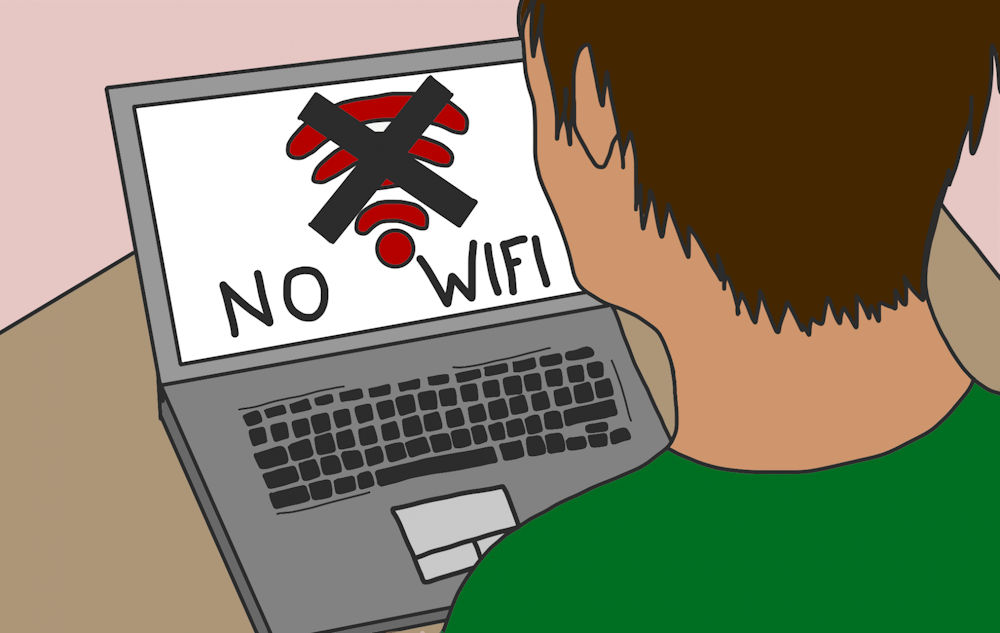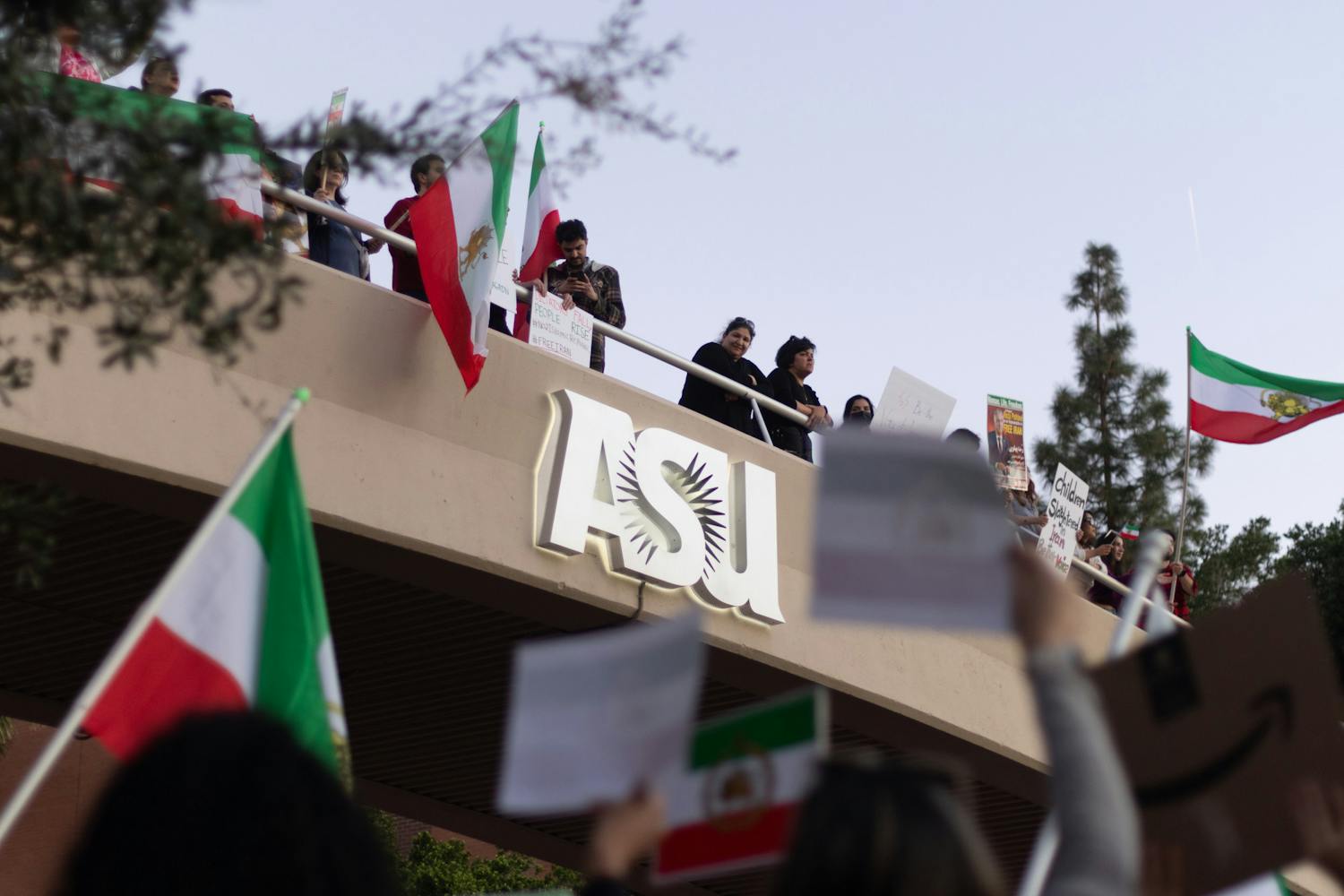For an ASU student in 2021, a typical day might begin with checking their email, Canvas notifications and group project's Slack channel. They might take notes from streamed lecture videos and spend the afternoon doing online research for a midterm paper. In between, they could visit a professor or academic advisor in their office hours — over Zoom of course.
But what happens when a student's personal device fails? What happens if a student's broadband internet is slow or insufficient? What happens when a student cannot meet the expectations of a college environment where up-to-date digital technology is not just necessary, but assumed?
Mary Haddad is a first-generation American immigrant student at ASU. Growing up, she faced a "struggle for access" to digital tools. Today, she notices how digital technology can be a barrier to success in higher education for some students.
"As I grew older I started to realize the systemic shortcomings in digital resource distribution which affects not only me but the generation of young scholars around me," she said.
In the emerging digital landscape of higher education, these systemic shortcomings mean some students have an easier time in school than others. When academic performance is contingent on what kind of technology a student has access to, there is something wrong with that academic system.
Technology needs should not impact a student's ability to learn and create in college. It is past time for colleges to take active responsibility for their students' tech needs when it comes to personal device quality and broadband access.
If they don't, poor, marginalized and disadvantaged students will only face greater challenges as education technology becomes more sophisticated and ubiquitous.
Education technology
ASU — the national No. 1 university in innovation — prides itself on early adoption and implementation of emerging education technologies. ASU's online degree option is top-ranked, with tens of thousands of students enrolled every year.
The University began using Canvas as its learning management system in 2018 after years with Blackboard, obtained University-wide Zoom licensing in 2018 and made Slack available University-wide in 2019. Together, these key digital technologies make up the backbone of education tech today, consisting of coursework software, video conferencing and digital communication.
Punya Mishra, an associate dean in the Mary Lou Fulton Teachers College, has worked in the field of education technology since before the advent of the internet. He said he believes education technology has revolutionized the way we learn, work and attend school.
However, Mishra emphasized the tools universities and colleges use must not be so glorified for their capabilities that we forget the personal, day-to-day contexts in which they are used.
"These tools don't exist in isolation," he said. "They exist within a broader social matrix, social context. And so as you can imagine the effects of broader society are also felt on them."
Most of the education technology ASU uses requires up-to-date personal devices and internet connection. A few years ago, students may have been able to get by with outdated devices or limited internet access by using public technology on campus or communicating with their instructors in person.
In 2020, the COVID-19 pandemic massively disrupted this state of affairs.
While many students engaged in some form of blended or technology assisted classrooms, the COVID-19 pandemic exposed nearly all students to virtual learning. In the spring of 2020, most universities began an experimental "sync" approach with tools like Zoom lectures and online exam proctoring, which some instructors had never used before.
As universities return to in-person class formats, issues of tech inequity in education become more visible than ever. Not all students have the same access and capabilities when it comes to digital technology.
The digital divide
The digital divide is a multifaceted term referring to inequity in access, ability and benefits reaped from digital technologies.
These inequities take varied forms and look different across different groups. In education, they might look like students not having personal computers in their homes, not having access to broadband internet or lacking the digital fluency necessary to perform online homework.
COVID-19 did not create new divides, but rather exacerbated and revealed pre-existing inequities, Mishra said.
Mishra explained the pandemic revealed that ideas of the internet creating universal access to information are not true for all groups. "The inequities that exist in the broader society just became starker at this point in time," he said.
In Arizona and across the United States, these inequities are subtle yet persistent. According to Pew Research Center, the shares of Americans without access to essential technologies "have not significantly changed" over the course of the pandemic.
Around 40% of Americans with household incomes below $30,000 do not have in-home broadband internet. Almost a quarter of those in the same income bracket do not have a smartphone. 13% do not have a personal computer, smartphone or broadband connection at all.
1 in 7 Arizonans live in an area without adequate broadband infrastructure. At ASU, there is a documented history of Indigenous students struggling with a digital divide on reservations and other tribal lands, where some believe they are "more disconnected than ever."
Mishra argues these inequities are emblematic of general demographic disparities in America.
"There are groups which are disadvantaged — who have historically been so — and this pandemic, at least in the education space, has affected them worse than other groups. That's a fact."
Even if a student hypothetically has the required technology to participate in class, barriers persist. As the prevalence of education technology grows, the expectations for tech capabilities do as well.
Many professors now consider smartphones to be just as essential to success in college as personal computers. When last-minute Canvas notifications for cancelled class and collaboration group chats are the norm, smartphones become less of an advantage and more of an expectation.
Others note that, while many students have functional personal devices, some cannot keep them maintained and up-to-date in the rapid cycle of software updates and hardware upgrades. This has been called "the new digital divide," and some research shows it is already developing along racial and class lines.
Haddad sees the continuing digital divide as a product of neglectful or dismissive universities. She believes universities play a key role in ending the divide and their action begins with acknowledging the problem.
"Academia and the education system ... need to make a cohesive effort to target the root of the issue of digital inequity," Haddad said. "Which lies in a general inability of academic authorities to recognize that barriers to knowledge and success of students differ based on sociocultural background and economic status."
Bridges and solutions
In July, Haddad and other advocates held a panel discussion at the Future of Tech Commission Town Hall — part of the University's efforts to address digital division. They discussed personal experiences with lack of broadband access and digital equity from an Indigenous, Latine and socio-economic perspective.
One panelist, Lourdes Pereira, an ASU student majoring in justice studies and American Indian studies, said digital equity and access is an issue that affects the majority of sovereign nations. As an Indigenous student, she said she has personally faced these struggles herself.
The Future of Tech Commission is a public-private task force working with federal lawmakers to shape digital infrastructure policy. With Biden's infrastructure bill recently passed, the promise of improvements to broadband infrastructure in Arizona is encouraging, though the effectiveness of its implementation remains to be seen.
But at ASU, it is unclear why the digital divide is so hard to bridge. The University is a national leader in innovation and maintains partnerships with some of the wealthiest companies in the world, but some of its own students still struggle to get their basic educational needs met.
"I'd really implore tech companies to realize and actualize — kind of walk their talk," Lorena Austin, an ASU graduate of Chicana/o and Latina/o transborder studies, said during the town hall. "They could at this moment provide those monetary means to these communities, but don't, for probably a variety of reasons."
Haddad said it seems like ASU is not doing everything they can, especially considering the digital infrastructure it already has in place.
She is concerned about the University's priorities, which she feels resemble that of a business rather than an educational institution. While ASU devotes money to new construction projects each year, Haddad said she wishes the University would make sure the students who the buildings are for "actually have the resources they need to succeed within them."
"When we zoom out and look at (ASU) as an institution, it's starting to look like a business to me," she said. "And it's hard for me to not think that when needs that seem so simple and intuitive are being disregarded."
There are some promising efforts underway to address tech equity, including the ASU Digital Equity Initiative, which recently helped bring internet access to eight families in Phoenix's Isaac Elementary School District.
One University press release purports it is "advancing solutions for digital equity," though not much more is publicly known about this initiative.
Austin, Haddad and others express a pointed critique of how universities operate logistically — that digital inequity is often more of a policy choice than an inevitable dilemma outside of the University's control.
If the University expects students to have consistent, high-speed internet connection and up-to-date personal devices, then it needs to do everything in its power to meet the needs of students who struggle with these requirements.
ASU has many equity task forces, but still fails to effectively prioritize its spending and allocation of resources to address inequity effectively. It is time for the University to prioritize its students' needs.
Mishra maintains his belief that education technology has the potential to make college more accessible and inclusive than ever before. However, he noted that we are at a transition point which threatens to leave even more students behind if not handled seriously and effectively.
"We have to pay a lot more attention to issues of digital equity than we had before," Mishra said. "Whether it's access to broadband, or whether it's access to devices, because you can't do good teaching and learning if you don't have access."
Reach the reporter at ammoulto@asu.edu and follow @lexmoul on Twitter.
Like The State Press on Facebook and follow @statepress on Twitter.
Continue supporting student journalism and donate to The State Press today.




